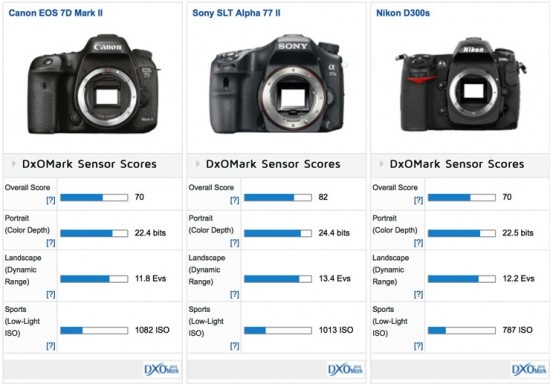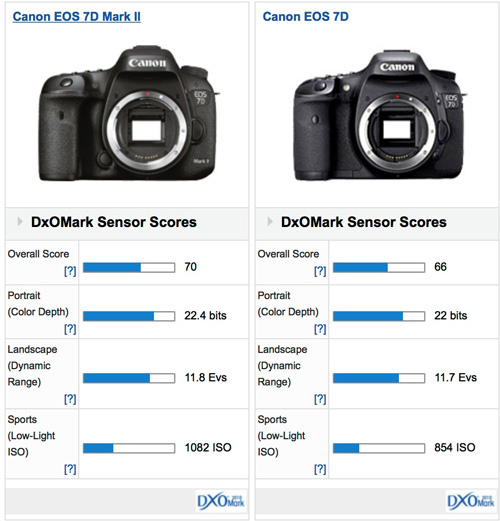The guys at Photo Rumors tested the new Canon EOS 7D Mark II and the DxOMark results are a bit haunting for Canon users. In the comparison charts below they found the highly anticipated Canon EOS 7D Mark II tests similar to the five year old Nikon 300s. Has Canon hit a plateau in meaningful updates to push themselves ahead of the rest of the pack? With comparisons to five year old Nikon systems, it could be the case.
Needless to say, having waited long enough for the highly rumored Canon EOS 7D Mark II, I was very excited to get my hands on the new Canon flagship crop sensor to see the major differences. Using the previous model for a few sporting events here locally it was nice to see updates in focus and speed though slight it was an upgrade. Being a Canon shooter from the start it has been a slow go at finding truly innovative jumps in bodies recently. Waiting for the next variation to only find its being compared to older Nikon or Sony bodies is discouraging and has kept me holding on to my older Canon gear even longer.
Below are some of the screen grab comparisons for the Canon EOS 7D Mark II.



On paper, the Canon EOS 7D Mk II looks to be a solid choice for sports and action photographers, but its sensor performance is somewhat behind the best in class, at least at low ISOs. Relatively high noise, less discriminating color, and below-average DR at base ISO all continue to hold back Canon sensors against rivals, but that’s not the case at higher sensitivities. In fact, when light levels fall, the Canon EOS 7D Mk II performs competitively, even surpassing rivals slightly. If Canon could only address performance at base and low ISO, the EOS 7D Mk II would make a thoroughly convincing all-round choice, but in this category the Sony A77 II looks to be the more compelling option. - DxOMark Conclusion Statement
What do you think? Have we seen a plateau in updates from Canon or camera bodies in general? Am I alone in thinking companies are taking after the Apple update scheme in releasing slight evolution steps rather than revolutionary steps as they seem to tote each year in marketing plans?
[via Photo Rumors]







So the Sony Alpha gets a score of 82 while the Canon gets a score of 70. Which seems like a huge difference to me. But when you look at it, the Canon has better ISO performance, and has better DR at higher ISOs. So a sports camera used at higher ISOs it is the absolute clear winner. I just don't understand how this score helps anyone that will use the camera? And how does more low ISO DR help a sports shooter? I understand portraits and landscapes, but sports?
Well with any shooter you want the best shot possible overall. That includes creatively and technically essentially. If you can sacrifice the quality of the image for the creative look and feel its fine most of the time but if you have the option to pick up a nice DSLR that can shoot at higher ISO and allow you to capture an even sharper image for further uses that would essentially be best right? I think that is where sports photography with this camera plays a big role. Having just a little more freedom than tested to have the possibilities to shoot in lesser conditions. One guy above mentioned the majority of his sports events are smaller and have terrible lighting though the higher levels of sporting events have great lighting. Not always the case for all sports sadly. I came to that issue this summer when shooting for a local sports team outdoors.
So in terrible lighting conditions, the 7D2 would be the best option. Better IQ at higher ISOs including lower noise and higher DR.
Actually, the Nikon D7100 camera has about 30% higher ISO than the Canon 7D Mark II and yet cost 50% less. And the Nikon D750 (6.5 fps) has about 3 times the ISO as the Canon 7D2 (10 fps) though, but it is 28% more expensive. Now 6.5 fps is great for sports unless you are a high end pro. So technology wise, the Canon 7D Mark II is not very interesting. This is a problem for Canon as far as prosumers are concerned.
As a Canon I'm sad about it, but a little part of me is happy that my 7D can keep chugging along and I don't *need to replace it.
*by need I mean REALLY want to but not actually need to.
I have shoot Canon and Nikon for various newspapers. There are more than one factor for picking camera than sensors. Also if you look at sensors it is a lot like looking at film. Photographers will choose a film or sensor for purely subjective reasons, like tonality. Also there are a whole list of reasons such as the camera actions, lens selection\, video and AF for picking a camera.
I currently own Nikon one the major reasons is the camera system AF system. The other thing is I think Nikon is more focused on still images. Basically Nikon makes still cameras that can shoot video while Canon cameras have a stronger focus on video.
Also when the Nikon D3 and D300 came out in 2007, they were revolutionary in their concept low noise sensors vs more mega pixels. It took Canon until late 2008 to make the Canon 5d mark II to start competing with Nikon with low noise and that camera had a lot of glitches to iron out, but did have a more practical video system than Nikon.
So sensors alone is not a way to judge a Camera system.
Ralph, I like your commentary, it is balanced and quit objective. You bring up a good point which I will expound on. Nikon is a camera company that incorporates video while Canon is a video company that incorporates camera functionality. It is the difference between stills and motion that has distinguished their inherent focus. The image quality for individual video frames is not as demanding as that for individual stills. That is why Canon has been more aggressive in their algorithm in removing noise at higher ISO than Nikon in stills. So Nikon stills are cleaner at higher ISO settings. What Canon may not have realized is that Nikon has quietly gained parity in its cameras built-in video capabilities and may have surpassed Canon as seen with the Nikon D810 camera.
But few people know that Nikon designs image sensors. Now with Nikon using Sony to manufacture their sensors, Nikon can introduce design changes to the Sony sensors to meet Nikon's specific requirements. That is why given the same sensor, Nikon's DxOMark performance can be as high as 30% higher than Sony. Nikon has now become a more formidable company in the camera segment than in the past, and this poses a serious competitive threat to the competition. The Nikon D4s, D810, and D750 are just the beginning. Nikon is now reading the D400 and D7200 cameras that will seriously challenge the 7D Mark II. The D750 with its extremely high ISO and low light performance (-3 EV) now appears as the ideal camera for wedding photographers. And the D810 with its superior dynamic range seems like the ideal camera for wedding, event, and nature photographers when superior sharpness with capable high ISO is demanded. The cropping factor and video capability of the D810 is stunning.
Canon will continue to do well in the mass market, but it looks as if they will lose a lot of prosumers in the 12 months.
I was hoping to see a bit more out of the sensor, as I wasn't happy with my 7D at ISO 1600+, but for all of the hype over the DxOMark ratings, it's funny that you can't tell a Nikon shot from a Canon shot, or Sony, Pentax, etc. despite their vastly superior sensor ratings. The other features and especially the lenses make far more difference in 95% of situations. I think the 7DII will sell like hotcakes and we'll be seeing lots of amazing shots with it despite it's supposedly inferior sensor...
You are absolutely right, however everyone is upset if their camera doesn't have the dynamic range to push files 5+ stops in post production. For some reason if you have maximum DR at base ISO it far outweighs anything the sensor can do at higher ISOs, which is where Canon really shines.
You can tell the difference between a Nikon shot and a Canon shot if you put them side by side. Nikon pictures at higher ISO are significantly cleaner and sharper than Canon. But for most people, they do not think about the image quality of a shot when they see a picture. But this discussion is not about the general public but prosumers and discerning customers!
Yes, if you take the same shot and compare them side-by-side, but if you look at finished, processed photos on the web or in magazines like National Geographic, there's no way to tell them apart unless you view the EXIF data or know what equipment the person uses.
That is definitely not true at all. I am a wedding photographer and I have shot with several Nikon second shooters and the absolutely only thing I have seen in their files is that ability to recover more highlights in a blown out wedding dress on a sunny day. At high ISOs I have yet to see anything better than my 1DX.
sony a7 family blowed all with cheap and light
I am kind of bemused....
getting the mental picture of the finish line of a marathon run; the winner coming in 2/100 of a second before the runner- up.
Now the winner gets hailed to high heaven, loosers all suck and haven't really been practicing and all.
C'mon, or as the late great Joan Rivers used to say: "Get a life!"
Face it, the wheel hadn't been reinvented by canon and the competition hadn't been shipping square wheels either. Or was it vice versa?
We're comparing great cameras with phantastic ones, beating out amazing cameras, ahead of a field of superb ones.